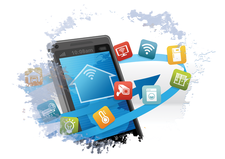ioBroker integrates different smart home protocols into a single easy interface
Many in One

The smart home market includes a number of different vendor environments. You'll need a capable broker to fit them under one roof.
The story of the Tower of Babel teaches us that stagnation and confusion can ensue when the community does not have a common language. In today's world, your own smart home project can fail if the components in your Internet of Things (IoT) community do not understand each other. So far, the IoT industry has not settled on a single, uniform language for home automation. Instead, various IoT vendors have their own competing communication systems. If you purchase all your IoT gadgets from the same vendor, the whole network will chatter harmoniously, but if you don't want to be locked into a single vendor environment, you might be wondering how you could ever manage these babbling devices from a single interface.
One interesting solution for the IoT Tower of Babel dilemma is ioBroker [1], an extremely capable broker and interpreter for home automation projects. The ioBroker project was launched in 2014, and it continues on with strong support from a dedicated developer community.
What is ioBroker?
ioBroker offers a single user interface for managing IoT devices from several different vendor environments (Figure 1). The ioBroker system comes with a collection of software components called adapters that interface with the various hardware environments. The number of ioBroker adapters has increased from 100 to more than 180, and the count is still increasing. The adapters are installed individually, so you will never have more than you need.
[...]
Buy this article as PDF
(incl. VAT)
Buy Linux Magazine
Subscribe to our Linux Newsletters
Find Linux and Open Source Jobs
Subscribe to our ADMIN Newsletters
Support Our Work
Linux Magazine content is made possible with support from readers like you. Please consider contributing when you’ve found an article to be beneficial.

News
-
Debian Unleashes Debian Libre Live
Debian Libre Live keeps your machine free of proprietary software.
-
Valve Announces Pending Release of Steam Machine
Shout it to the heavens: Steam Machine, powered by Linux, is set to arrive in 2026.
-
Happy Birthday, ADMIN Magazine!
ADMIN is celebrating its 15th anniversary with issue #90.
-
Another Linux Malware Discovered
Russian hackers use Hyper-V to hide malware within Linux virtual machines.
-
TUXEDO Computers Announces a New InfinityBook
TUXEDO Computers is at it again with a new InfinityBook that will meet your professional and gaming needs.
-
SUSE Dives into the Agentic AI Pool
SUSE becomes the first open source company to adopt agentic AI with SUSE Enterprise Linux 16.
-
Linux Now Runs Most Windows Games
The latest data shows that nearly 90 percent of Windows games can be played on Linux.
-
Fedora 43 Has Finally Landed
The Fedora Linux developers have announced their latest release, Fedora 43.
-
KDE Unleashes Plasma 6.5
The Plasma 6.5 desktop environment is now available with new features, improvements, and the usual bug fixes.
-
Xubuntu Site Possibly Hacked
It appears that the Xubuntu site was hacked and briefly served up a malicious ZIP file from its download page.

